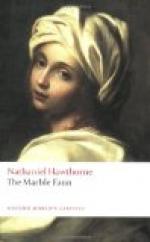“You should go with me to my native country,” observed the sculptor to Donatello. “In that fortunate land, each generation has only its own sins and sorrows to bear. Here, it seems as if all the weary and dreary Past were piled upon the back of the Present. If I were to lose my spirits in this country,—if I were to suffer any heavy misfortune here,—methinks it would be impossible to stand up against it, under such adverse influences.”
“The sky itself is an old roof, now,” answered the Count; “and, no doubt, the sins of mankind have made it gloomier than it used to be.” “O, my poor Faun,” thought Kenyon to himself, “how art thou changed!”
A city, like this of which we speak, seems a sort of stony growth out of the hillside, or a fossilized town; so ancient and strange it looks, without enough of life and juiciness in it to be any longer susceptible of decay. An earthquake would afford it the only chance of being ruined, beyond its present ruin.
Yet, though dead to all the purposes for which we live to-day, the place has its glorious recollections, and not merely rude and warlike ones, but those of brighter and milder triumphs, the fruits of which we still enjoy. Italy can count several of these lifeless towns which, four or five hundred years ago, were each the birthplace of its own school of art; nor have they yet forgotten to be proud of the dark old pictures, and the faded frescos, the pristine beauty of which was a light and gladness to the world. But now, unless one happens to be a painter, these famous works make us miserably desperate. They are poor, dim ghosts of what, when Giotto or Cimabue first created them, threw a splendor along the stately aisles; so far gone towards nothingness, in our day, that scarcely a hint of design or expression can glimmer through the dusk. Those early artists did well to paint their frescos. Glowing on the church-walls, they might be looked upon as symbols of the living spirit that made Catholicism a true religion, and that glorified it as long as it retained a genuine life; they filled the transepts with a radiant throng of saints and angels, and threw around the high altar a faint reflection—as much as mortals could see, or bear—of a Diviner Presence. But now that the colors are so wretchedly bedimmed,—now that blotches of plastered wall dot the frescos all over, like a mean reality thrusting itself through life’s brightest illusions,—the next best artist to Cimabue or Giotto or Ghirlandaio or Pinturicchio will be he that shall reverently cover their ruined masterpieces with whitewash!
Kenyon, however, being an earnest student and critic of Art, lingered long before these pathetic relics; and Donatello, in his present phase of penitence, thought no time spent amiss while he could be kneeling before an altar. Whenever they found a cathedral, therefore, or a Gothic church, the two travellers were of one mind to enter it. In some of these holy edifices they saw pictures that time had not dimmed nor injured in the least, though they perhaps belonged to as old a school of Art as any that were perishing around them. These were the painted windows; and as often as he gazed at them the sculptor blessed the medieval time, and its gorgeous contrivances of splendor; for surely the skill of man has never accomplished, nor his mind imagined, any other beauty or glory worthy to be compared with these.




